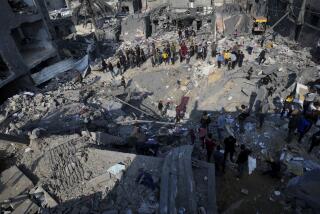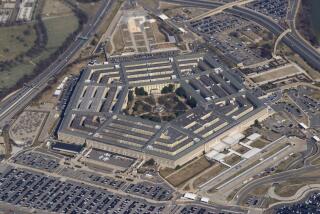Experts Say Photos Are Misleading
WASHINGTON â The photographs released by the Pentagon this week depicting pockmarked runways and shattered aircraft portray a successful U.S. bombing campaign in Afghanistan, but military experts warn that the carefully selected images reveal far less than meets the eye.
Scant details about the effectiveness of the airstrikes can be gleaned from the more than two dozen images released by the Defense Department, which says it is hitting targets with an 85% success rate.
Independent experts interviewed Friday said the images tell a story of a U.S. bombing campaign that appears to have handily picked off easy aerial targets, such as buildings and airstrips. In fact, some Taliban targets--such as a row of aging Soviet MIG fighters lined up in plain view--appeared so vulnerable in the photographs that some experts wonder whether they were Taliban decoys.
Others suspect that the photographs reveal an astonishing lack of preparation and resourcefulness on the part of Taliban troops, who appear to have done little to camouflage equipment or salvage it after it was struck.
Anthony Cordesman, a former Defense Department intelligence officer and now senior fellow at the Washington-based Center for Strategic and International Studies, said the photographs donât show whatâs really going on in the military campaign.
âThe photos are chosen because the missions were successful and because they are not revealing,â Cordesman said. âTrying to second-guess them is ridiculous.â
Defense officials have declined to talk at length about the photographs, saying the images speak for themselves.
In addition to trying to keep a tight lid on information that might prove helpful to the extremist Islamic regime in Afghanistan, the military is still stinging from criticism leveled after the 1991 Persian Gulf War, when military photographs and video footage drastically overstated the effectiveness of the bombing campaign.
âThey are being careful this time not to sell air power as a silver bullet, as they have in the past,â said Mackubin Owens, a strategy professor at the Naval War College in Newport, R.I.
The Pentagon has released 21 photographs and five videos, providing before and after shots of at least 10 targets, including three airfields, three surface-to-air missile sites, two terrorist training camps, a radio station and a regiment headquarters. (The photographs are available on the Internet at the Pentagonâs Web site, https://www.defenselink.mil.)
Experts say the Pentagonâs photographs so far have focused on the kinds of targets the U.S. military is good at hitting, such as large objects, both fixed and mobile.
More telling is the fact that the Pentagon has not released images or statistics about harder-to-reach targets such as tanks, troops and underground facilities, according to Michael OâHanlon, senior fellow at the Brookings Institution, a Washington-based think tank.
âItâs not so much a question of whether weâre hitting 85% or 75% or 65% of targets,â OâHanlon said. âThe notable thing to me is that the targets weâre trying to hit so far seem to be limited to the kinds of things weâve always been good at. Itâs a little like a high school football player bringing home a report card that shows an âAâ in physical education.â
Others also questioned the significance of some of the targets depicted in the Pentagon photos.
One photo shows about 20 MIG fighters and a cargo plane at Herat airfield in northwestern Afghanistan. The post-strike picture shows nearly all the aircraft broken into pieces.
Tim Brown, a senior analyst at GlobalSecurity.org, said a closer look at the photographs reveals that the fighters were probably Korean War-era MIG-15s, MIG-17s or MIG-19s, not the newer MIG-21s and MIG-23s that Taliban forces reportedly have.
âBecause theyâre older aircraft and piled up in a row, it looks to me that the Taliban put them there as a decoy,â said Brown, who served in the Air Force and has been studying military satellite photographs for four years. âItâs a classic deception technique. In the Gulf War, the Iraqis lined up their junk aircraft, hoping weâd hit them and be distracted from striking other areas.â
He said U.S. military officials may have realized that the aircraft were decoys but hit them anyway to mislead the Taliban into thinking the U.S. had been fooled. The strike also provided the military with compelling photographs that didnât reveal any sensitive information, he noted.
âItâs a balancing act,â Brown said. âYou want to give out enough to satisfy the public and the media, but not so much that you give away any weaknesses.â
Cordesman, however, said he suspects that the photos reveal ineptitude on the part of the Taliban forces.
âTheyâve been amazingly negligent in some cases, leaving equipment in place after something has been struck,â Cordesman said. Even damaged or nonoperational aircraft and vehicles are still useful for providing spare parts and resupplies, he noted.
A senior Defense Department intelligence official confirmed Friday that Taliban troops do not appear to be as resourceful in defending their targets as Iraqi and Serbian troops were in the Gulf War and the 1999 campaign to protect the Yugoslav province of Kosovo.
The photos also suggest that the U.S. bombing has been selective and based on intelligence reports, experts said.
A shot of the destruction to the Mazar-i-Sharif Divisional Regiment Headquarters in northern Afghanistan indicates that U.S. bombers targeted certain buildings in the camp but left others untouched, suggesting that U.S. intelligence officials provided guidance about which facilities to strike, Brown said.
Likewise, U.S. forces donât appear to have bothered to bomb dozens of combat vehicles parked around the camp, the photographs suggest. Because the vehicles had not been relocated by Taliban troops after the attack, Brown said, he believes they might be nonoperational vehicles, parked at the camp as another decoy.
(BEGIN TEXT OF INFOBOX / INFOGRAPHIC)
Before, After
Herat airfield, northwestern Afghanistan
Apparent damage: Destruction of Soviet MIG fighters and a cargo plane.
Analysts say: Possible decoys. Fighters appear to be Korean War-era MIGs, not MIGs that Taliban forces use today. âItâs a classic deception technique,â says one expert.
*
Mazar-i-Sharif Divisional Regiment Headquarters, northern Afghanistan
Apparent damage: Evidence of selective targeting based on intelligence reports.
Analysts say: Bombers targeted some buildings, left others untouched. Untouched combat vehicles may be decoys. Unmoved equipment reveals ineptitude of Taliban forces, one expert says.
More to Read
Sign up for Essential California
The most important California stories and recommendations in your inbox every morning.
You may occasionally receive promotional content from the Los Angeles Times.










